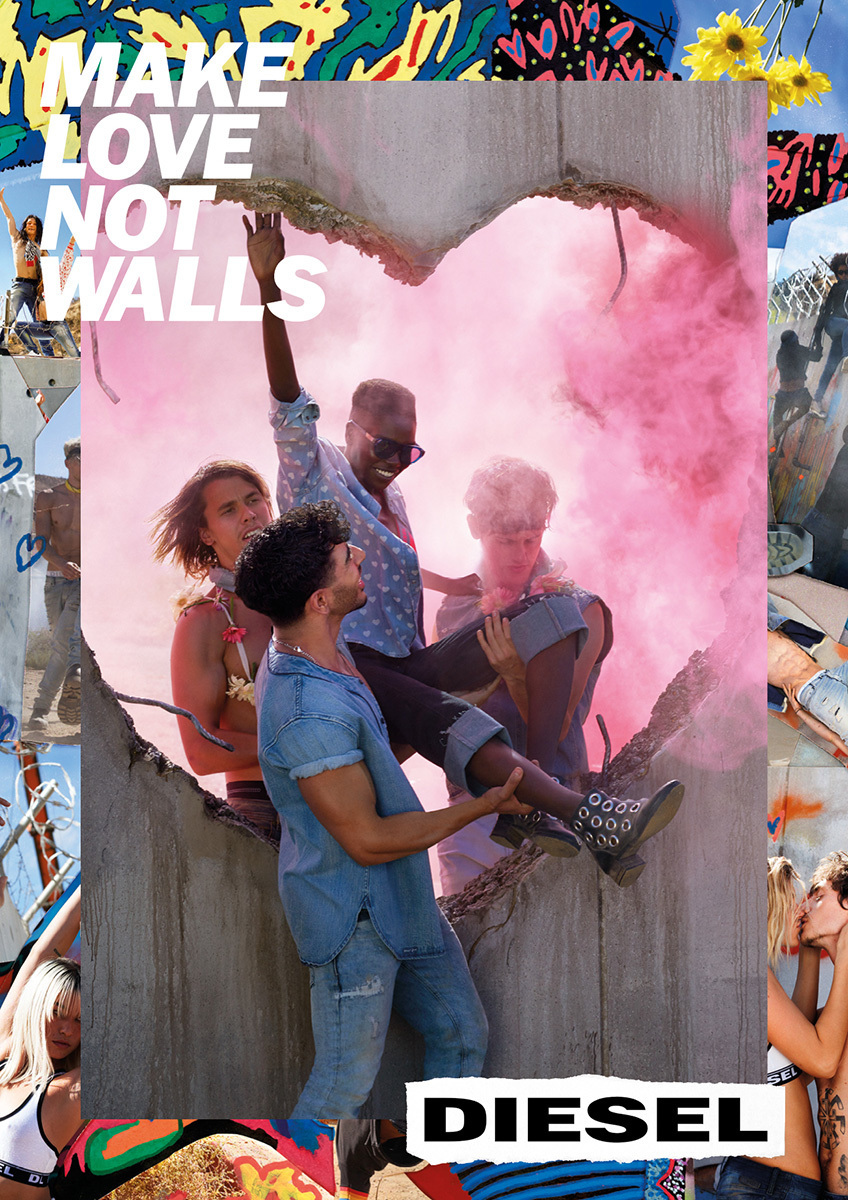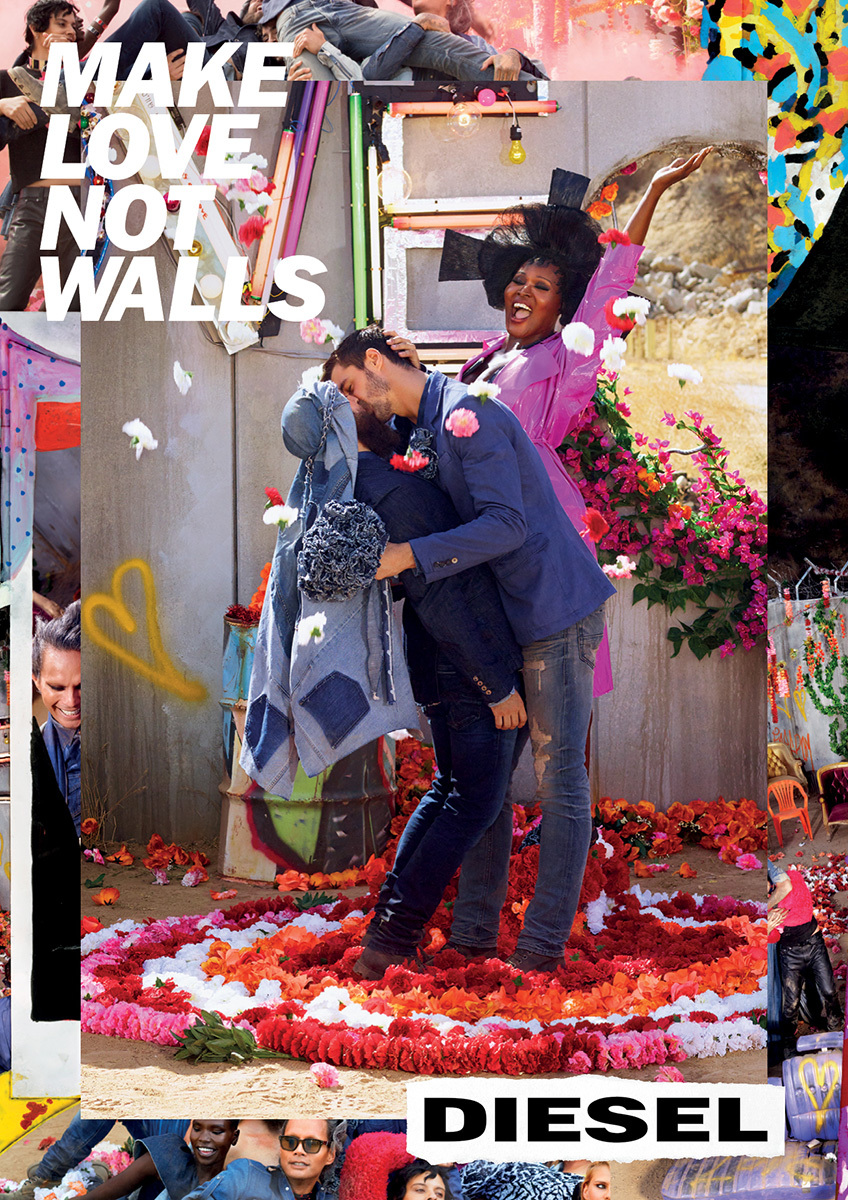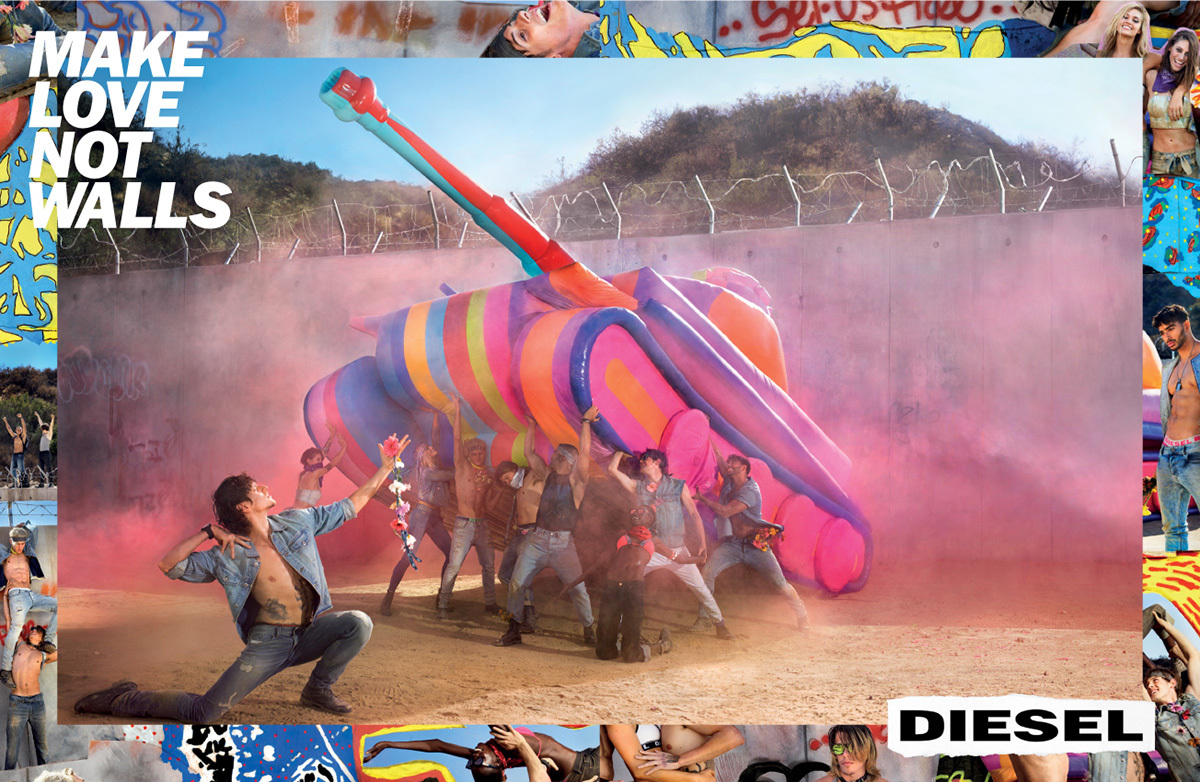Having entered the world of fashion and art when he was taken under Andy Warhol’s wing at Interview magazine at 17 years old, David LaChapelle is known for going against the grain. When black and white photography and subdued grunge looks were all the rage in the 90s, LaChapelle presented the world with hyper-saturated color and surrealist scenes in his distinctive portraits, advertising campaigns for the likes of M.A.C, and iconic covers of The Face and i-D. After taking time out from the fashion whirlwind to focus on fine art, the photographer has now teamed up with long time collaborator Diesel to shoot its latest campaign.
While aptly titled for the current post-Trump climate, the #makelovenotwalls campaign is not just about tackling the President’s divisive proposal for a wall on the Mexican border. It’s about tearing down all the mental and physical walls that separate us in our everyday lives, putting togetherness and positivity at the center. Casting plays an integral part of the campaign and its ambition. The casts’s diverse members were not just static models, but collaborators who worked together with LaChapelle and Nicola Formichetti, the Italian brand’s artistic director, on the ad. Its members range from artist Stefan Meier and ballet dancer Sergei Polunin to queer artist Karis Wilde and transgender model Octavia Hamlett.
It’s easy to question whether the world of fashion campaigns is the right space to discuss political and social issues. The industry is still seen by many as superficial, and, not forgetting the elephant in the room, advertising exists to drive sales. However, when dissecting campaigns such as this one, it’s clear that it’s far from a frivolous, throw-away statement. In difficult times, positive messages are key and LaChapelle has a skill of taking in the current climate and turning it into powerful imagery which can have a profound impact. It’s not the first time LaChapelle has achieved this with Diesel.In 1995 — shortly after the Clinton administration implemented the Don’t Ask, Don’t Tell policy concerning openly gay, lesbian, and transgender people serving in the military — LaChapelle and Diesel created an advert depicting two male sailors kissing. As an international campaign, the iconic imagery was one of the first advertisements to show a gay couple kissing to 72 countries across the world. It was a big moment for many LGBTQ people everywhere.
Advertising subconsciously supplies us with constant messages. If those can be positive, diverse, and representative of how we want the world on the other side of the billboard to look, then why not. We had a chat with the legendary LaChapelle to discuss staying positive and the power of advertising.

The casting for the new campaign is incredible. Were you involved in the casting process?
Oh yeah, Nicola and I were involved in everything. It was a lot of friends and people we knew. Stefan Meier is my friend, he’s an artist and was featured in the campaign. On the set I said I wanted to use collages to tell the story and suggested Stefan could connect the images with his drawings. Octavia Hamlett is featured, who was a trans sex worker who won a pageant recognizing her support for other transgender women while she herself was homeless, as well as ballet dancer Sergei Polunin who I’ve worked with before. It felt like working on a student project with everyone pitching in; it was really beautiful. That’s when creative shit gets made. It felt exactly how these pictures look, and was continual over the course of three days of shooting in the desert. We didn’t stop when the camera said cut, it was like a mini festival or something. It was a great experience shooting it. It wasn’t contrived. When Octavia is laughing in the pictures, she was really fucking laughing. It wasn’t like, ‘okay, look like you’re laughing now, everyone jump and laugh.’ Smiles and laughter are so subversive in magazines now anyway because we see so little of it. It was great to capture these natural, real moments.
The campaign you did for Diesel in 1995 was one of the first advertisements to show a gay couple kissing. Do you remember how you felt at the time and what the reaction was like?
Gays in the military was a was a big topic with the Don’t Ask, Don’t Tell policy being instated and I approached Diesel founder Renzo Rosso with the idea for the ad. We didn’t do it to win awards or anything. At the time, what was being questioned was if openly gay people should be allowed to serve in the military, like it was a new thing. I just wanted to make a statement commemorating that gay people had been in the military since there ever was a military. Not only should we ‘allow them’ in, we should fucking thank them. That’s what Diesel did and allowed me to do.
When we created the ad, everyone was shooting black and white. It was a very desaturated, grunge-y time and I had come out with these weird colors in The Face and other magazines. I was ‘the color guy’. So Renzo wanted it in color but I said it can’t be if it’s going to be a period photograph and he let me do it in the end. We had no idea it was going to be as huge as it was. As it was an international advert in 72 countries, it was seen everywhere. It’s not like an art gallery or an editorial in a magazine. We had such an insane response, people still talk to me about it. Even a friend who was once at West Point, a military academy, was telling me that he was on the way to a football game and he saw the ad in a magazine and was like, ‘oh my god!’ It really touched him because he was in the closet at the time and it helped with him coming out. We passed a gay and lesbian bar a few years ago and it was still on the wall there, taped up and all yellowed. For me, it was like, never mind a national gallery. It was so cool to see that that there, and that it’s still been there for all those years.

Why do you think campaigns such as #makelovenotwalls are so important?
Advertising is a huge thing because you’re reaching so many people. This new campaign isn’t for the people who already have their minds made up. It’s not for those who are already steeped in fear and exclusion, who are on the far-right. [It’s not] for those hating Muslims or hating blacks or hating gay people, or whatever they’re hating. This isn’t for them. This is for the people who are still undecided. Hopefully, they see this campaign and see that these people look healthy and happy. We have an Olympic athlete, a male ballet dancer, a female to male transgender model Laith de la Cruz. There’s Stefan the artist, a Muslim model, and others who don’t identify with any religion, and everyone is together having a good time. Then there’s the wall that represents fear and oppression and separating people. A wall like they have in Palestine, like they had in Berlin, and now like what Trump wants to build on the border of Mexico. Whose side do you want to be on? Maybe some of the next generation will think ‘actually, the former sounds like more fun.’ Because it is more fun to love than hate. It is more fun to be inclusive. Hating is not fun at the end of the day; it comes out of a fear and emerges from a very dark, scary place. There’s no happy endings for people who live their lives based on fear and hatred.
Do you think it’s important for the fashion industry to be used as a platform for political and social subjects?
I think every part of culture and society is a platform to discuss these subjects. It’s essential to retaining our human and civil rights. You can’t compartmentalize what we do and who we are. If we work in fashion then we have to employ our ideas on how to live in that way. I work in photography, you might work in fashion journalism, but we have to carry our beliefs with us. Otherwise what are we doing? Why should we divorce ourselves and live one way privately and one way publicly? We have to be true to ourselves and what we believe the whole time. Luckily, a company like Diesel is not just interested in selling product, but putting these positive messages out there as well. You can achieve both.
Was it your idea for the inflatable tank? How did that concept come about?
Yes it was. I really like the idea of taking something that’s a symbol of death and destruction, bombing and war and turning it into this playful symbol of creativity. People want to look at beautiful things, they don’t want to be repelled by things that are ugly that you don’t look at for very long. You see that in the news every day, that’s what you get bombarded with. That’s why I wanted to create something that turns people on rather than repels them and then has something to say once you have their attention.
Your images often promote positivity rather than dwelling on the negative aspects of life. I think now, with such a continuous flow of news and information, it is easy to feel overwhelmed by the negative things. Do you ever find this difficult, to stay positive?
We all fall into darker periods in our lives and we have to pull ourselves out of it; it’s one thing we all have in common as humans. We have to pull ourselves up and focus on what we have and be grateful for the things that we do have in our lives. Sometimes you have to just turn it all off, and I think that’s an extremely important thing to do. You have more time to think. Just because we’re busier doesn’t mean we’re getting more done. Solitude is super important for artists and human beings. It’s good not to be plugged in all the time.
What’s the most important thing you’ve learned working in the fashion industry?
Learning how to communicate. I worked a lot with Isabella Blow and Franca Sozzani of Italian Vogue, i-D, and The Face who really allowed me to do great things. I started in galleries, and then started working for Interview Magazine, and then went back for the last 10 years working with galleries and exhibitions again. Really, the years of college for me was working at magazines. It was like my university; that’s where I learned how to really communicate with imagery and the marriage of concept, aesthetics, and the conceptual — putting all those things together. When I look at a magazine I think, ‘okay, I can kind of predict what the rest of it is going to look like so I’ve got to make this pop.’ I always want people to stop and look at my story and take something away.
Credits
Text Lula Ososki
